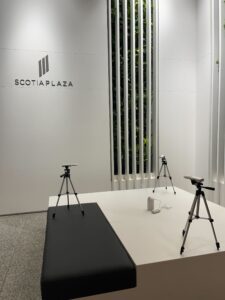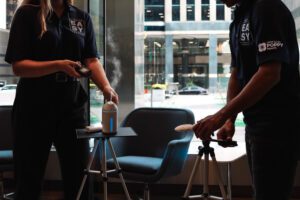A lot of public health depends on measuring proxies for health, such as checking the level of COVID-19 in waste water as a cheap, accurate and (importantly) privacy-preserving way to determine how widespread the disease is in a municipality. Recently, Poppy Health has created a clever technology to determine how well buildings are protecting people from air-borne diseases.

I talked to Sam Molyneux, who bears the unusual job title of Co-CEO at Poppy Health. This article describes their technology and some of the important results they achieve with it through an initiative they call BreatheEasy.
How to Measure Air Quality Cheaply
The inexpensive sensors used in the BreatheEasy project don’t measure the actual presence of the SARS-CoV-2 virus in the air (although Poppy Health markets another device that does that). In fact, the sensors don’t measure any aspect of air quality directly. Rather, they determine how fast air is being removed and replaced in the room–significantly, how each building breathes out airborne viruses to keep occupants from exposing each other to respiratory infections. This ventilation rate becomes a proxy for air quality.
For every room that Poppy Health wants to measure, they install two small devices. The first releases benign particles consisting of water, salt, and synthetic DNA. This mix is very easy to measure using their sensors. The second device waits 15 minutes after the release of the particles and determines how many are still in the air. The more particles containing that DNA are detected, the slower air circulation is.

The advantage of this kind of indirect measurement is that devices are cheap enough to scatter throughout hundreds of buildings simultaneously. They are also easy to deploy, hundreds of buildings can be enabled within a week. Furthermore, Molyneux says the devices tend to be more accurate than other types of measurement, which measure air at vents near the ceiling. Poppy Health measures at the floor level, the area actually occupied by people.
We’ll see how Poppy Health is taking advantage of this ability to “deploy at scale,” as computer system administrators sometimes say.
Public Health on a Massive Scale
The biggest deployment of Poppy Health’s sensors so far is in Toronto, where they installed sensors in 119 public spaces such as lobbies, corridors, and public meeting rooms over a six-week period. As one might imagine, ventilation quality varied greatly.
The standard measurement used for ventilation is Air Changes per Hour (ACH). A higher ACH means better protection from viruses and bacteria, with 4.0 being the minimum recommended score. Pedestrian walkways in Toronto tended to fall below this line. Other spaces met the standard, some having much higher scores than others.
Many clients have made instant improvements to spaces by adding air purifiers, which can be done quickly and cheaply. Poppy Health also involved the public in the initiative, polling the Toronto residents to find their concerns about air quality and which spaces they most desire to have measured.
In mid-2022, Poppy Health was invited by the California school system to place sensors in 71 schoolrooms to see how well air was being filtered. They measured classrooms, libraries, lunch rooms, etc., finding that 59% failed to meet the 4.0 ACH standard, and a whopping 93% failed to meet California’s own recommendations. I didn’t see enclosed spaces such as cloak rooms, stairwells, and corridors in the results—those spaces would probably rate even worse.
Poppy Health is prepared to take their sensors around the continent, and eventually around the world. They plan to measure public spaces where they are invited for free, and to charge for measuring private spaces. Besides measuring the quality of a space, they can compare the results of people masking with a lack of masking.
A Warm Welcome
Interventions into public health are often hard to push: Many require investments, organizational changes, and political decisions that encounter resistance. In contrast, Molyneux has found that potential clients are eager to use Poppy Health’s sensors.
He says that the movement to digitize buildings and create smart cities has grown a great deal during the past five years, familiarizing administrators with the use and value of sensors. The goal of improving ventilation became particularly urgent, of course, after COVID-19 hit. Everyone is worried about whether the store or classroom or concert they attend will make them sick.
The BreatheEasy project is a great illustration of how creative approaches to technology can be combined with public outreach to make measurable, significant improvements to health.













